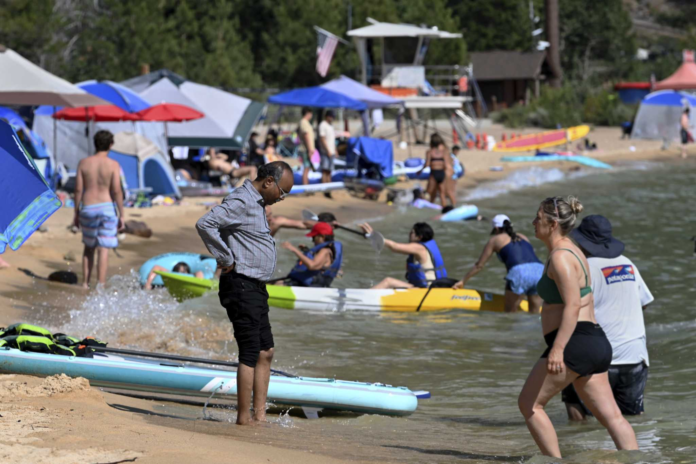This is a carousel. Use Next and Previous buttons to navigate
SAND HARBOR, Nev. (AP) — Lake Tahoe tourism officials were surprised, and a bit miffed, when a respected international travel guide put the iconic alpine lake straddling the California-Nevada line on its list of places to stay away from this year because of the harmful ecological effects of overtourism.
But with an influx of visitors and new full-time residents due to the COVID-19 pandemic already forcing local leaders to revisit the decades-old conversation about overcrowding, “Fodor’s No List 2023” may have served as a wake-up call that some sort of change is necessary.
“I can’t go to my own beaches anymore,” said Susan Daniels, 70, a lifelong resident of Kings Beach, California, whose parents met at a Tahoe-area ski resort in 1952. That includes her favorite, Sand Harbor, which lies just across the Nevada border and is known for its turquoise water and rock formations. “I cannot go to Sand Harbor, where I grew up, unless I get in line at 7 in the morning.”
Since Fodor’s declared last November that “Lake Tahoe has a people problem,” some unlikely voices have expressed a new willingness to consider taxes or fees on motorists, a nonstarter not long ago.
Meanwhile local business and tourism officials are lining up behind a new effort to persuade people to check out less trafficked parts of the lake and to visit outside of high season.
The idea is to preserve a $5 billion local economy built around the tourists who come to hike, camp, boat, bike, ski and gamble, while also easing their impact on the environment and communities. Roughly one-third the size of the Sierra Nevada’s also-crowded Yosemite National Park, the Lake Tahoe Basin gets about three times as many visitors — around 15 million each year.
“We know that we really need to get out of the tourism marketing business and get into the tourism management business,” said Carol Chaplin, CEO of the Lake Tahoe Visitor’s Authority.
“And that has a lot to do with the Fodor’s article, really. How are we managing our tourism?” she said. “Not that it is overtourism — I think that was a little bit shocking. But we are not denying some of that.”
This month saw the unveiling of the Lake Tahoe Destination Stewardship Plan, a 143-page document backed by a broad coalition of more than a dozen conservation, business, governmental and private entities that prioritizes “sustainably preserving” the goose that lays the golden egg — the twinkling cobalt waters that turn blue-green near the lake’s 72 miles (115 kilometers) of shoreline.
Two years in the works and full of ideas but short on specifics, the document has as one emphasis easing traffic gridlock, which causes not only parking nightmares but increased air pollution and lake sedimentation.
The plan also considers measures adopted by other tourist destinations, such as requiring reservations, timed-entry permits and capacity limits.
But “we’re not a national park,” said Amy Berry, CEO of the nonprofit Tahoe Fund. “We don’t have gates. We’re not going to ever shut the door on folks.”
The document does not carry the weight of law, and there is no enforcement mechanism to ensure the aspirations it lays out come to fruition.
Tahoe officials have talked this way before. But they insist this time’s different.
Congestion has reached such a critical point that it’s time to adopt “user or roadway pricing to limit the vehicles in the basin and incentivize the use of public transit,” said Washoe County Commission Chairwoman Alexis Hill in Reno, Nevada, the closest major city, about 20 miles (30 kilometers) northeast of the lake.
One of an increasing number of people to take that view, Hill knows the idea that would have been dismissed out of hand a decade ago by hotels, casinos, ski resorts and other business concerns opposed to anything that might discourage visitors.
And she acknowledged it won’t be easy, especially because of the multiple jurisdictions involved, including five counties in two states, individual towns, regulators, the Coast Guard and the U.S. Forest Service.
“But honestly, I think people may have recognized we may already be getting to the point of unsustainability,” Hill said.
“When you have folks like Fodor’s say, `Don’t go to Lake Tahoe,′ that’s not good for us as a region. We need folks to visit here, but we need a system to manage them,” she said.
Berry, Chaplin and others believe two key strategies for managing tourism are encouraging midweek and off-season visits and promoting hidden gems that many tourists have never seen — such as Spooner Lake, an underutilized site above the east shore where a new visitor’s center and parking lot recently opened.
“There’s a lot to explore in the Tahoe Basin,” Berry said.




